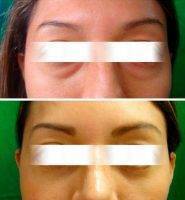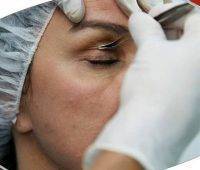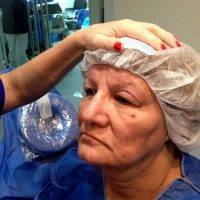Asymmetrical Eyes After Blepharoplasty
At just over two weeks after Blepharoplasty surgery, it is normal to have some asymmetry. This may affect both the skin and the fat of the lower eyelids, and may also affect the shape of the eye
There can be more swelling or bruising on one side versus the other, even if the identical procedure was performed, and identical amounts of fat were removed.
Four to six weeks after eyelid surgery, most of the early asymmetry caused by the above problems should be resolved
In the interim, follow the recommendations of your surgeon, keep your head elevated as much as possible, use cool compresses, use artificial tears and eye ointment as necessary, and be patient. Your final result isn’t in the bag just yet!
With all due respect, 2 and 1/2 weeks is way too early to examine your blepharoplasty to determine if it was done well or not. Even when we start with symmetrical eyes, it is difficult to have post-operative swelling that is identical on both eyes
When you start with severe assymetry, the swelling will most certainly be assymetrical. I routinely tell my patients to wait 4-8 weeks before making any judgement as to the quality of the outcome.
So the best thing you can do to help your recovery is to relax and believe that your doctor did a great job
Positive thoughts lead to positive outcomes.
You should consult with your surgeon who will likely tell you that it is still too early to judge your results. Give it another few weeks. The reward of patience is patience. Good luck and I wish you a rapid and symmetric recovery

Asymmetrical Eyelids After Double Blepharoplasty
At just 2 1/2 weeks after surgery I wouldn’t count out healing. It is not unusual to get a fair amount of swelling under the eyes after lower eyelid surgery that can take a while to go away, sometimes even a month or two
Slight asymmetries in the eyelid as well can resolve given time and sometimes a little massage. I would highly suggest speaking with your physician about your concerns and getting his or her opinion.
Healing is a process
I appreciate your question because it is common for patients to judge their eyelids much earlier than appropriate. I tell patients to wait 3 months before deciding if they are pleased with the results.
Eyelid Swelling is Extremely Common Following Blepharoplasty
Eyelid swelling is extremely common following blepharoplasty. Following surgery, the majority of the swelling has disappeared in about a week, but small amounts may persist for up to a month. The swelling is typically worse in the morning, after lying down all night

Asymmetry Greater Than Or Equal To 1 Mm
It tends to improve during the day when the patient is in the upright position. It appears that your swelling is probably normal and would be anticipated after this type of procedure. Elevating your head at night might accelerate your recovery
If the swelling fails to improve, make sure you discuss the issue with your plastic surgeon.
2 and 1/2 weeks after eyelid surgery is not nearly long enough to draw conclusions about the final result.
Everything you descibe can be explained by post-operative swelling. Each week, you should see some improvement. Eventually, all the asymmetries and contour issues should resolve. This may take a number of months. As long as there is ongoing improvement, just follow things along with your surgeon
Natural asymmetry may become more visible with age.

Eye Asymmetry After Blepharoplasty
As others here have said, we’re all born with some degree of asymmetry between the left and right sides of the face and body, including the eyes. It’s not uncommon for any existing unevenness to become more apparent with age, even as young as you are
Although any current unevenness between your eyes appears very slight, as the aging process continues it may eventually be more apparent. I wound not consider any eyelid surgery at this time, but if the asymmetry becomes more pronounced, eyelid surgery can be performed just on one side to create better symmetry and reduce the signs of aging
Some asymmetry is normal.
It does not appear that the asymmetry between your eyes is outside of normal. Everyone has some level of asymmetry between their right and left side. As you age, some of these asymmetries become more apparentIf you are not noticing any disturbance or disruption in visibility and everything else seems normal, I would say to just wait and see. If signs of aging progress faster on the dominant side of the face, you may want to check with a plastic surgeon about using some BOTOX® Cosmetic to even things out a bit
In most cases, the eyelid shape and contour is different because of a difference in the size, shape, or position of the orbit (eye socket). In cases where there is a crease on one side and not on the other, this can be remedied with a relatively straightforward surgery
In most cases, though, no treatment is needed.
No one’s face is perfectly symmetrical, no matter how closely it may seem to be even on both sides. From your photo, any asymmetry between your left eye and your right is very subtle
I don’t think that any of your normal facial expressions would have caused a permanent change in your eye and brow placement, and don’t think eyelid surgery is needed for correction at this time

Eyelid Asymmetry In Patients Evaluated For Upper Lid Blepharoplasty
However, if you’re concerned, or feel there’s been an unexplained and rapid change in your appearance, it might be worth checking with a physician to rule out any underlying causes, and gain peace of mind
your asymmetry appears to be very subtle (and within normal limits). You should see a board certified plastic surgeon in your area to examine you, but based on this picture I wouldn’t offer you any surgery
Asymmetry of the eye and orbit are extremely common and when looked at closely, most people have some asymmetry. In your case, asymmetry is present, although it is relatively minor. I would not recommend treatment for this type of mild deformity because of the risk benefit ratio
When the potential for improvement relative to the complication rate is minimal, this is not a risk worth taking. It is very important for asymmetry to be pointed out during the pre-operative analysis. Patients often don’t note mild asymmetry prior to surgery
In most cases of mild asymmetry, there is some asymmetry of the bones surrounding the eye. This cannot be treated without major surgery. If you continue to have concerns about your asymmetry, it would be appropriate to consult a board certified plastic surgeon
every person’s right side of the face is different, to a variable degree, than the left side. Sometimes these differences are very subtle, and other times they are striking. It is important for the cosmetic surgeon to make note of these differences when evaluating a patient
Often I find the patient was not aware of these differences, only seeing that one brow was lower, or their nose was crooked, but not seeing the big picture. In some people one eye projects further out of the socket than the other
You may be born this way, or there are many acquired medical causes- some serious. I can not tell from your photo, but this can be checked by any type of plastic surgeon or eye doctor
Finally we all carry one brow higher than the other involuntarily. This is the dominant eye (just like you have a dominant hand). As with most people, you carry your right brow higher, suggesting right eye dominance
This is normal. If disturbing, a small amount of Botox above the right brow will give you more symmetry.
Eyelid asymmetries are normal
There is asymmetry with the eyelids whereby there is a higher crease on left side upper eyelidthan on the right. Eyelids are always asymmetrical. However, the degree of asymmetry is variable. The lower eyelids are also asymmetrical, with the left one showing more rounding
the degree of asymmetry here is minimal, so it is probably best to leave well enough alone


